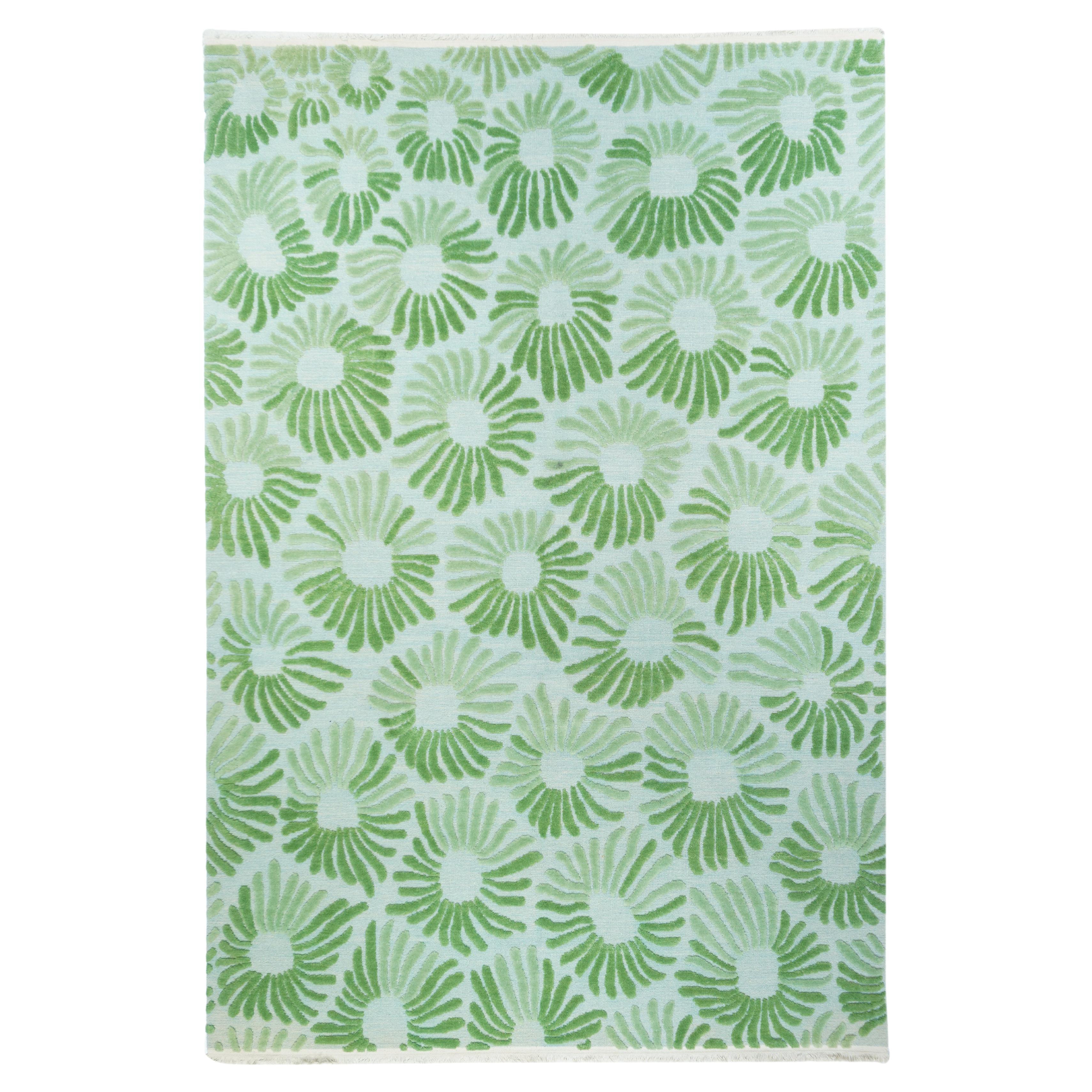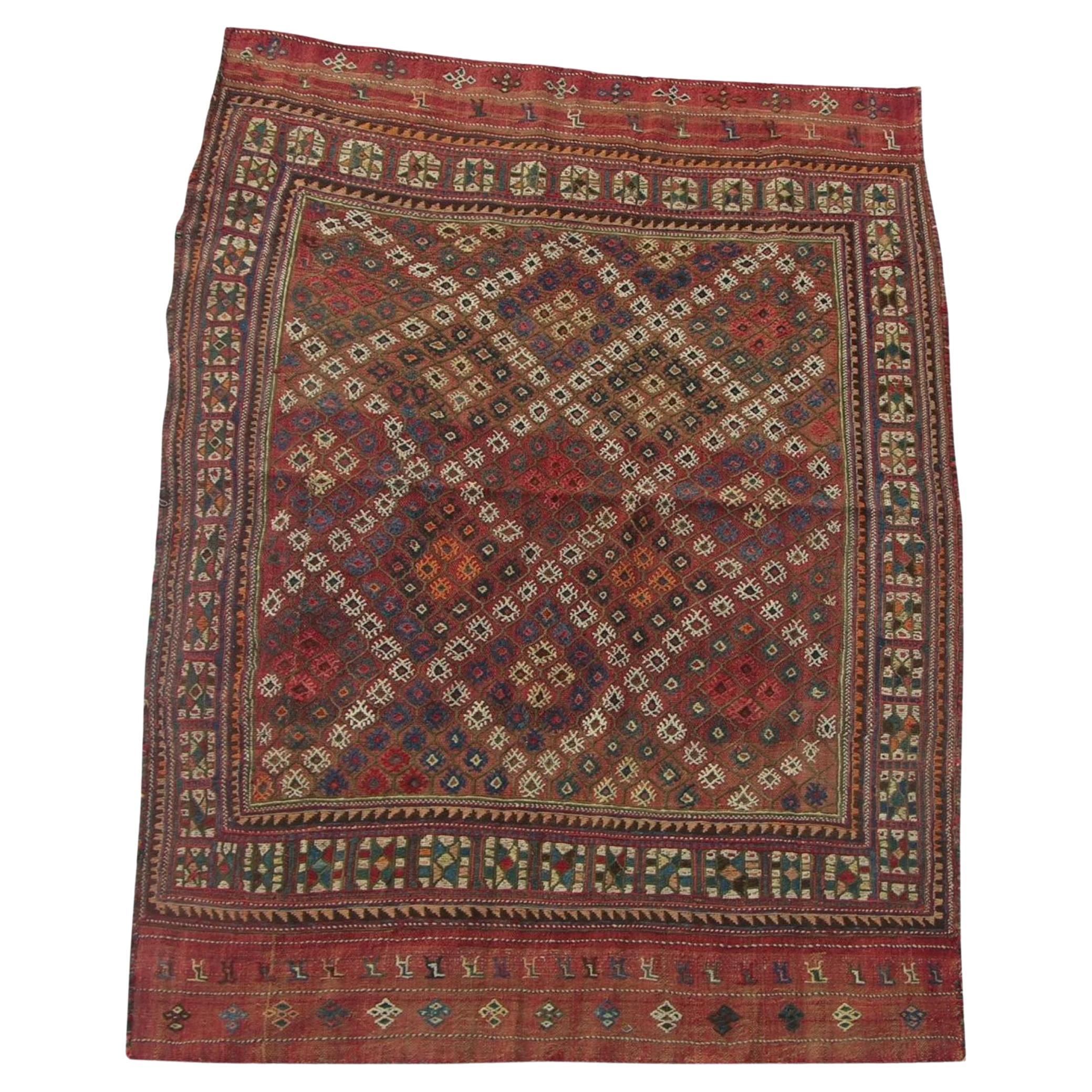Items Similar to Antique Sumak Rug
Want more images or videos?
Request additional images or videos from the seller
1 of 5
Antique Sumak Rug
About the Item
Soumak rugs (also spelled Sumak) – This construction technique produces a flat-weave rug that is thick, strong and exceptionally durable. Unlike kilims, Soumak rugs are not reversible because non-clipped yarns are left on the back. However, they are also stronger than kilims.
Antique Soumak carpets are unique because the wefts are used to produce decorative patterns rather than as a structural element. Antique Soumak rugs are generally very finely woven and feature richly detailed motifs. Traditionally, these spectacular flat-weave carpets are decorated with ancient symbols, tiny birds and geometric animals. Many of these geometric patterns and tribal symbols are associated with the Shahsavan tribe. In the 17th century, these influential warriors served as the personal bodyguards to Shah Abbas according to historic legends. The Shahsavan, who used Soumak weaving techniques widely, inhabited modern-day Azerbaijan and parts of Northwest Persia near Ardabil.
Because Soumak rugs were woven in various carpet producing regions, the designs they feature are exceptionally diverse. Although they are fairly rare compared to pile carpets and traditional kilims, antique Soumak rugs feature grand medallions, finely executed repeating patterns, Persian garden designs and tribal motifs that are surrounded by multiple sets of richly detailed borders. Antique Soumak rugs make outstanding floor coverings, but the technique was also used to construct bags, trappings, saddle covers, decorative bed spreads and functional household items. Like other regional handicrafts, antique Soumak rugs are highly decorative and diverse textile pieces that flatter modern furnishings and soften minimalist interiors very well.
Soumak or Sumak is a type of brocading or flat-woven pile. Thicker than a kilim carpet, it is accomplished by looping the yarn horizontally around successive pairs of warps in between passes of over-under wefting. When compressed vertically with a weaver’s comb, the resultant texture looks like cabling rising slightly from the surface of the rug. Soumak is named for the village of Shemaka in the Caucasus where this technique was widely practiced, but it certainly was not invented there. Soumak has been practiced extensively across the antique rug producing world, from Central Asia to Iran, the Caucasus, and Turkey.
- Dimensions:Width: 35 in (88.9 cm)Length: 52 in (132.08 cm)
- Style:Other (In the Style Of)
- Materials and Techniques:
- Period:1900-1909
- Date of Manufacture:1900
- Condition:good condition.
- Seller Location:Los Angeles, US
- Reference Number:
About the Seller
5.0
Gold Seller
These expertly vetted sellers are highly rated and consistently exceed customer expectations.
Established in 1920
1stDibs seller since 2023
30 sales on 1stDibs
Typical response time: <1 hour
- ShippingRetrieving quote...Ships From: Los Angeles, US
- Return PolicyA return for this item may be initiated within 3 days of delivery.
More From This SellerView All
- Antique Nomadic Sumak Rug - 5'10'' X 4'3''Located in Los Angeles, USAntique Nomadic Rugs: – To most people the concept of the area rug, especially the pile rug, is virtually synonymous with the Orient, above all P...Category
Vintage 1910s Tribal Russian and Scandinavian Rugs
MaterialsWool
- Antique Turkish Silk RugLocated in Los Angeles, USTurkish rugs (also referred to as Anatolian rugs) are, arguably, the rugs that started it all. These carpets were among the first wave of Oriental antique carpets to be exported into Europe. The vintage Turkish rugs were prized commodities and artistically influential pieces. The designs of Turkish rugs such as the iconic guls, prayer rugs and small repeating patterns found on these carpets, worked their way into the iconic paintings of the European masters, including Memling, Lotto, Bellini, Hans Holbein and many others. These painters were inspired so much by Turkish rugs and the design motifs they feature that the artists have lent their names to some of these famous Turkish patterns. One of the most famous artists that incorporated rugs from Turkey in his painting was the great and iconic 16th century painter Hans Holbein. The styles of Turkish rugs...Category
Antique Early 1900s Asian Other Russian and Scandinavian Rugs
MaterialsWool, Cotton
- Antique Chinese Small RugLocated in Los Angeles, USAntique Chinese Rugs, as opposed to most of the antique rug productions, were woven almost exclusively for internal consumption. Since they were mostly sheltered from European and We...Category
Antique Early 1900s Asian Other Russian and Scandinavian Rugs
MaterialsWool, Cotton
- 1920s Antique Hamedan RugLocated in Los Angeles, USShirvan rugs – The historic Khanate or administrative district of Shirvan produced many highly decorative antique rugs that have a formality and stylistic complexity that is found in...Category
Antique Early 1900s Asian Other Russian and Scandinavian Rugs
MaterialsWool, Cotton
- 1910s Antique Kilim RugLocated in Los Angeles, USAntique rugs that are called “Kilim rugs”, primarily refer to a type of flat weave rug that was produced without knotted pile. Because these antique rugs are found across the globe, ...Category
Antique Early 1900s Asian Other Russian and Scandinavian Rugs
MaterialsWool, Cotton
- Antique Needlepoint Floral RugLocated in Los Angeles, USNeedlepoint rugs were created using the traditional needlework weaving technique that is used to make everyday items from furniture to carpets and artwork. However, it has a fascinat...Category
Antique Early 1900s Other Russian and Scandinavian Rugs
MaterialsWool, Cotton
You May Also Like
- Antique Caucasian Sumak Area RugLocated in New York, NYSoumak (also spelled Soumakh, Sumak, Sumac, or Soumac) is a tapestry technique of weaving strong and decorative textiles used as rugs and domestic bags. Baks used for bedding are kno...Category
Early 20th Century Russian Sumak Caucasian Rugs
MaterialsWool
- Sumak Area RugLocated in New York, NYSumak (also spelled Soumakh, Sumak, Sumac, or Soumac) is a tapestry technique of weaving strong and decorative textiles used as rugs and domestic bags. Baks used for bedding are know...Category
20th Century Chinese Sumak Chinese and East Asian Rugs
MaterialsCotton, Wool
- Sumak Area RugLocated in New York, NYSoumak (also spelled Soumakh, Sumak, Sumac, or Soumac) is a tapestry technique of weaving strong and decorative textiles used as rugs and domestic bags. Baks used for bedding are kno...Category
20th Century Chinese Sumak Chinese and East Asian Rugs
MaterialsWool, Cotton
- Sumak Area RugLocated in New York, NYSumak (also spelled Soumakh, Sumak, Sumac, or Soumac) is a tapestry technique of weaving strong and decorative textiles used as rugs and domestic bags. Baks used for bedding are know...Category
20th Century Chinese Sumak Chinese and East Asian Rugs
MaterialsWool, Cotton
- Sumak Area RugLocated in New York, NYSumak (also spelled Soumakh, Sumak, Sumac, or Soumac) is a tapestry technique of weaving strong and decorative textiles used as rugs and domestic bags. Baks used for bedding are know...Category
20th Century Chinese Sumak Chinese and East Asian Rugs
MaterialsWool, Cotton
- Sumak Manchoria Rug 6'0" x 9'0"Located in New York, NYSumak (also spelled Soumakh, Sumak, Sumac, or Soumac) is a tapestry technique of weaving strong and decorative textiles used as rugs and domestic bags. Baks used for bedding are know...Category
20th Century Chinese Sumak Chinese and East Asian Rugs
MaterialsWool, Cotton
Recently Viewed
View AllMore Ways To Browse
Antique Game Birds
Russian Antique Set
Scandinavian Modern Wool Living Room Sets
Scandanavian Modern Bed
Animals Birds Rug
Antique Bed Other
Antique Yarn
Bed Spreads
Saddle Cover
Bird Bar Set
Antique Modern Bed
Weaver Bird
Antique Flat Weave Tribal Rugs
Used Antique Saddles
Antique Handicrafts
Iranian Rug With Animal Motifs
Animal Clip
Wool Combs Used





